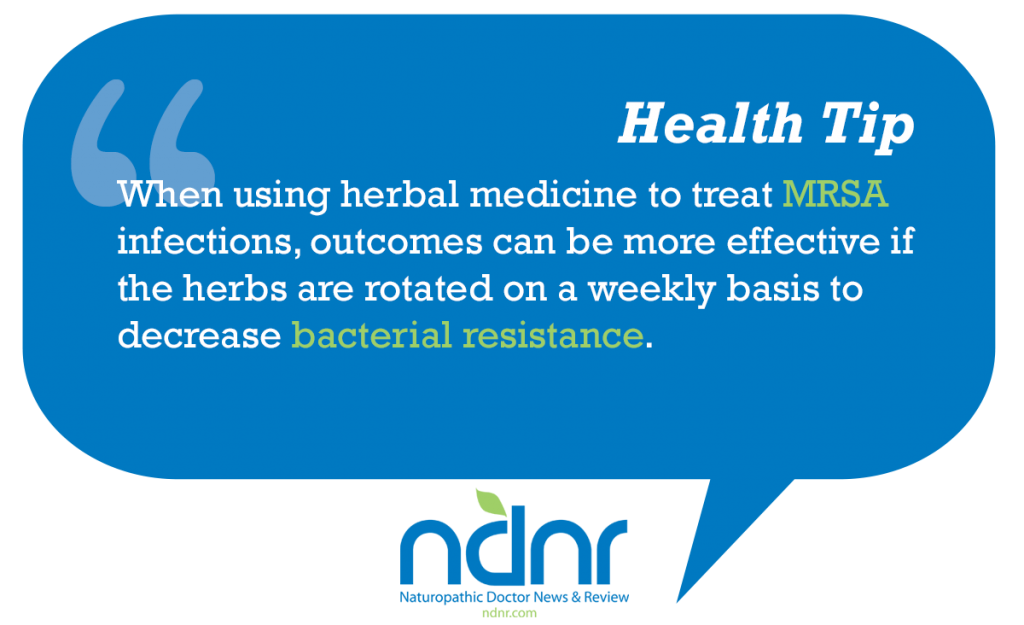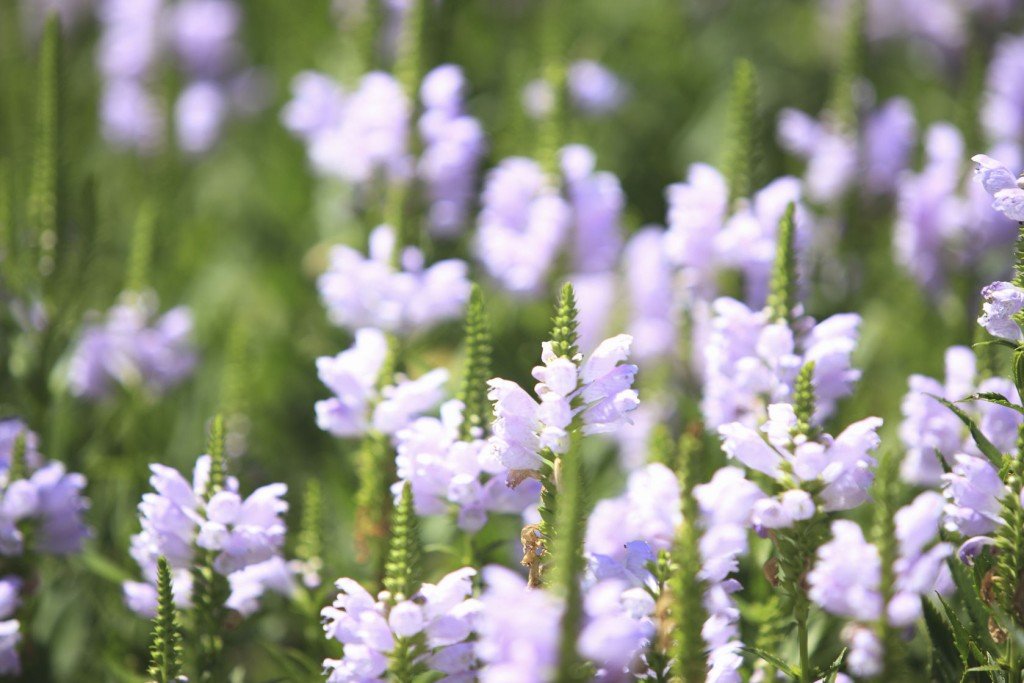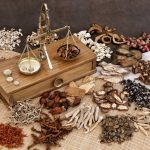Robin DiPasquale, ND, RH (AHG)
Do we know whether herbal medicine can effectively treat methicillin-resistant Staphylococcus aureus (MRSA)? If we look at the review of the literature done by Martin and Ernst,1 you may think not. Four electronic databases were searched for controlled clinical trials of antibacterial herbal medicine. It was reported that few controlled trials have actually been published, most are methodically weak, and the 7 trials that met the inclusion criteria were not able to demonstrate efficacy of the herbs against MRSA. Going behind, around, and beyond current evidence in the literature, herbs have historically been used as antiseptic, antimicrobial, and antibiotic agents to resolve bacterial infections, stemming back to our roots. It is the way herbs are used in treatment that can be the key to successful outcomes in the case of MRSA or any antibiotic–resistant condition.
Bacteria are very clever. They can learn resistance and pass this on genetically to future generations. There are 3 mechanisms by which bacteria can become resistant to antibiotics:
- by changing their DNA structure so they are no longer susceptible or damaged by the antibiotic;
- by manifesting multidrug-resistant pump action to detox from the antibiotics at their cellular level, a form of detoxification for the bacteria; and
- by forming biofilms, mucilaginous conglomerates of organisms comprising a protective barrier against the drug (bacterial toxin) targeted at the bacterial cells.
Herbal medicine can yield the actions needed to address one or more of the ways that bacteria can become resistant to antibiotics.
When working with MRSA and herbal medicine, there are several pathways that can be considered:
- The herbs are antimicrobial in their own right, meaning they can be used alone instead of antibiotics.
- Herbal medicine can work concurrently with the antibiotic, to ensure double action toward the antimicrobial treatment.
- Herbs can be used to potentiate the antibiotic treatment.
- Using herbs, the immune system can be enhanced, strengthened, and activated to respond to and protect the body from harm, including Staphylococcus infections, which can become life-threatening.
- Herbal medicine can break up or prevent the formation of biofilms.
When using herbal medicine to treat MRSA infections, outcomes can be more effective if the herbs are rotated on a weekly basis to decrease bacterial resistance. Use one herb or herbal formula for 1 week, then change the herb or formula in week 2, and then alter the herb or formula again in week 3. After a 3-week rotation, you can return to the herb or formula used during week 1 and cycle through again. Depending on the virulence of the infection, it could take 1, 2, 3, or more cycles to rid the body of the infection. There can be time between the 3-week cycles, but be sure to keep the treatment strong and consistent during the 3 weeks.
Some Herbal Materia Medica to Consider 
Herbs containing the berberine alkaloid, including Berberis species (barberry), Coptis chinensis (golden thread), Hydrastis canadensis (goldenseal), Mahonia aquifolium (Oregon grape), and Mahonia trifoliate (algerita), prevent all 3 mechanisms of bacterial resistance from occurring. Although they are not well absorbed, their action at the mucous membrane level throughout the gut, as well as reflexing to other mucous membranes in the body, can kill bacteria and other organisms that may be causing dysbiosis. These alkaloid-rich plants damage the cell wall of bacteria, enhancing the antimicrobial and antibiotic action. Through better microbial balance in the gut, the immune system is supported and enhanced.
Ocimum sanctum (holy basil), known in India as tulsi, is a member of the Lamiaceae family. Tulsi is reverenced in Hindi households, where the matriarch brings daily offerings and prayers to the tulsi plant. The mint family plants contain volatile oils that act as antimicrobial agents. Holy basil is a plant medicine to be considered as part of the treatment in almost all cases of MRSA. In a 2005 study2 in which 10 Indian medicinal plants were investigated for their ability to inhibit MRSA and methicillin-sensitive S aureus (MSSA), O sanctum extract showed more favorable results than Allium sativum against MRSA strains. In the study, several herbs, including Camellia sinensis, Lawsonia inermis, Punica granatum (rind), and Terminalia chebula and Terminalia belerica, showed synergistic action with the antibiotic tetracyline, with C sinensis also showing synergism with ampicillin.
Scutellaria baicalensis (Baical scullcap) has been used across the history of Traditional Chinese Medicine for treating infectious diseases. Although an antimicrobial-acting herb in its own accord, in the search for new approaches to combat the bacterial resistance of MRSA, investigators combined the isolated flavone baicalin with several antibiotic agents.3 The outcomes showed that the combination potentiated the killing of MRSA and penicillin-resistant S aureus.
We know Curcuma longa (turmeric) primarily for its inflammation-modulating and antioxidant actions. The extract of turmeric can be significant in its effectiveness, targeting inflammatory diseases like arthritis, but can also be effective against bacterial infection such as MRSA. However, absorption is key with turmeric. In a study4 published in 2005, it comes as no surprise that an ethyl acetate extract of C longa was more active against MRSA than methanol or water extracts. When considering C longa in treatment, be sure to use a form that is highly absorbable.
While many of our volatile oil–containing plants yield antimicrobial action, Thymus vulgaris is one of the stronger antimicrobial phenolic herbs in our materia medica. Thyme infusion, tincture, or essential oil can be applied both internally and topically.
The production of biofilms is one of the ways bacteria have become resistant to treatment. Nepeta cataria (catnip) has shown some ability to break down biofilms, opening the gate for other antimicrobial herbal treatment or more effective treatment with antibiotics.5
The antimicrobial and antibacterial activity of Allium sativa (garlic) is well documented, historically and in contemporary literature. When including garlic as one of the herbs in rotation when treating MRSA, its antimicrobial activity can be utilized more effectively, decreasing the potential for the bacteria to develop tolerance.
Used extensively by the Eclectic physicians for bacterial infections in combination with Echinacea species, Inula helenium (elecampane) shows promise in the current literature for its antimicrobial activity against MRSA and MSSA. In a 2009 study6 in Ireland, I helenium was tested against 200 staphylococci isolates and showed 100% effectiveness.
A water extract of Andrographis paniculata showed strong results when tested, along with 4 other individual herbs, for antibacterial activity against 5 strains of bacteria, including MRSA.7 Other herbs studied were Vitex negundo, Morinda citrifolia, Piper sarmentosum, and Centella asiatica.
Illicium verum (star anise) has antibacterial properties of its own, and it works synergistically with antibiotics. The supercritical carbon dioxide and ethanol extracts of I verum showed substantial antibacterial activity against 20 MRSA strains.8
Other herbs may be considered for these indications. They include Salvia officinalis, Arctostaphylos uva-ursi, pau d’arco, and Olea europaea leaf.
In Japanese studies,9,10 the herbal combination hochu-ekki-to has shown effectiveness in resolving MRSA. This formula contains the following 10 herbs: Astragalus membranaceus, Atractylodes chinensis, Panax ginseng, Angelica sinensis, Bupleurum chinense, Ziziphus jujuba, Aurantii nobilis, Glycyrrhiza uralensis, Actaea racemosa, and Zingiber officinale. The Japanese kampo formula is similar but includes different species of Atractylodes, Angelica, Bupleurum, and Actea.11
Resin Salve
Many years ago, a Bastyr University (Kenmore, Washington) student prepared a salve in the laboratory made from several resins. I began to use this salve topically for wound healing, with exceptional success. I have since prepared my own version of this resin salve and have seen its effectiveness when used topically with MRSA lesions.
Three of the resins are from trees in the Burseraceae family, namely, Commiphora species, Boswellia species, and copal, thought to be in the Bursera genus, although some copal seems to come from trees in the Guaiacum and Bulnesia genuses. Also included are Dracaena cinnabari, that beautiful red resin known as dragon’s blood, and the resin from Pinus species, found more locally throughout North America.
Myrrh is harvested from Commiphora myrrha or Commiphora molmol. Myrrh has antiseptic properties, stimulating the production of white blood cells.12 In Traditional Chinese Medicine, myrrh is a blood mover, clearing stagnation. It has inflammation-modulating action. In Ayurvedic medicine, myrrh is considered a tonic and rejuvenative, with specific application to the mucous membranes, as well as the cardiovascular system. Frankincense, a beautiful golden-colored resin, also known as olibanum, is harvested from trees in the Boswellia genus, often Boswellia sacra. This resin, too, has significant antiseptic properties due to the boswellic acids. In Traditional Chinese Medicine, frankincense is a qi mover, which can bring life and movement to areas of the body that are stuck or stagnant. Its inflammation-modulating ability is known in arthritic conditions, but the warmth and movement frankincense provides to any area of the body facilitate healing. In the research on copal, the exact genus and species of trees held sacred by these indigenous cultures is not exact because it seems that different regions used different variations. Knowledge of copal stems back to its ceremonial and healing uses by the people of Mesoamerica; however, it is also found in other areas of the world. Hymenaea verrucosa is used in East Africa, and the gum of the kauri tree is used in New Zealand. Copal resin, whatever its cultural origin, brings antiseptic, antimicrobial, and healing properties similar to those of myrrh and frankincense. Dracaena species (dragon’s blood) is a tree in the Asparagaceae family that is native to the Socotra archipelago in the Indian Ocean. Locally, the tree is known for wound healing. A 2012 study13 performed in China discusses the antimicrobial effects of the flavones found in Dracaena species. One last resin in the salve comes from a more local North American source, Pinus species. The essential oil of Pinus species, found in high concentrations in the pine resin, shows significant effectiveness against microorganisms, in particular Staphylococcus.14
To make the resin salve, grind the resins to a powder with a mortar and pestle, in whatever proportions of various resins you prefer to use. Add this resin powder to a carrier oil base. I use a combination of coconut, grape seed, jojoba, and rose hip seed oils. Allow the resin powders and oils to heat in a double boiler for 1 to 2 hours, stirring often. Add in beeswax. When the beeswax is melted, strain the mixture through a metal strainer to catch any powdered residue, and then pour the liquid salve into jars to set. Proportions of the resins can vary depending on which resins you want in larger or smaller amounts and which resins you have on hand. The ratio of oil to beeswax depends on how firm you like the final salve.
All the resins used in this salve formula are derived from trees. The output of resin is the mechanism that the tree uses to repair wounds and prevent infection. So, we are collecting their medicine, without harming the tree, and are applying their healing wisdom to our own bodies.
Conclusion
The evaluation and use of herbal medicines show antimicrobial action, which can decrease the resistance mechanisms that bacteria have so cleverly developed. However, it is of utmost importance in the treatment of any patient with MRSA infection to remember that we are treating the person, not the bacteria. In conjunction with any antimicrobial treatment, enhancing the body’s innate immune system is essential, which leads us to yet another topic to be discussed in more detail in another article.
 Robin DiPasquale, ND, RH (AHG) earned her naturopathic degree in 1995 from Bastyr University, Kenmore, Washington, where following graduation she served as a didactic and clinical faculty member for 15 years. Now located in Madison, Wisconsin, she currently practices at Red Lotus Healing Arts and the University of Wisconsin Integrative Medicine Program, weaving her passion and experience with herbal medicine, homeopathy, gemmotherapy, biotherapeutic drainage, and energy medicine into the healing of each individual. Dr DiPasquale continues as an adjunct faculty member at Bastyr University and teaches throughout the United States, in Italy, and in Canada, along with her ongoing online course in gemmotherapy. She travels often to Italy, studying gemmotherapy with her Italian colleagues, and is one of the leading gemmotherapy teachers in the United States.
Robin DiPasquale, ND, RH (AHG) earned her naturopathic degree in 1995 from Bastyr University, Kenmore, Washington, where following graduation she served as a didactic and clinical faculty member for 15 years. Now located in Madison, Wisconsin, she currently practices at Red Lotus Healing Arts and the University of Wisconsin Integrative Medicine Program, weaving her passion and experience with herbal medicine, homeopathy, gemmotherapy, biotherapeutic drainage, and energy medicine into the healing of each individual. Dr DiPasquale continues as an adjunct faculty member at Bastyr University and teaches throughout the United States, in Italy, and in Canada, along with her ongoing online course in gemmotherapy. She travels often to Italy, studying gemmotherapy with her Italian colleagues, and is one of the leading gemmotherapy teachers in the United States.
References
- Martin KW, Ernst E. Herbal medicines for treatment of bacterial infections: a review of controlled clinical trials. J Antimicrob Chemother. 2003;51(2):241-246.
- Aqil F, Khan MS, Owais M, Ahmad I. Effect of certain bioactive plant extracts on clinical isolates of beta-lactamase producing methicillin resistant Staphylococcus aureus. J Basic Microbiol. 2005:45(2):106-114.
- Liu IX, Durham DG, Richards RM. Baicalin synergy with beta-lactam antibiotics against methicillin-resistant Staphylococcus aureus and other beta-lactam–resistant strains of S. aureus. J Pharm Pharmacol. 2000;52(3):362-366.
- Kim KJ, Yu HH, Cha JD, Seo SJ, Choi NY, You YO. Antibacterial activity of Curcuma longa L. against methicillin-resistant Staphylococcus aureus. Phytother Res. 2005;19(7):599-604.
- Nostro A, Cannatelli MA, Crisafi G, Alonzo V. The effect of Nepeta cataria extract on adherence and enzyme production of Staphylococcus aureus. Int J Antimicrob Agents. 2001;18(6):583-585.
- O’Shea S, Lucey B, Cotter L. In vitro activity of Inula helenium against clinical Staphylococcus aureus strains including MRSA. Br J Biomed Sci. 2009;66(4):186-189.
- Zaidan MR, Noor Rain A, Badrul AR, Adlin A, Norazah A, Zakiah I. In vitro screening of five local medicinal plants for antibacterial activity using disc diffusion method. Trop Biomed. 2005;22(2):165-170.
- Yang JF, Yang CH, Chang HW, et al. Chemical composition and antibacterial activities of Illicium verum against antibiotic-resistant pathogens. J Med Food. 2010;13(5):1254-1262.
- Nishida S. Effect of Hochu-ekki-to on asymptomatic MRSA bacteriuria. J Infect Chemother. 2003;9(1):58-61.
- Karibe H, Kumabe T, Ishibashi Y, Sakai K, Shiina G. The effect of Japanese herbal medicine on MRSA carrier in neurosurgery [in Japanese]. No Shinkei Geka. 1997;25(10):893-897.
- Wikipedia. Bu zhong yi qi wan. http://en.wikipedia.org/wiki/Bu_Zhong_Yi_Qi_Wan. Accessed December 8, 2012.
- Dolara P, Corte B, Ghelardini C, et al. Local anesthetic, antibacterial, and antifungal properties of sesquiterpenes from myrrh. Planta Medica. 2000;66(4):356-358.
- Chen HQ, Zuo WJ, Wang H, et al. Two new antimicrobial flavanes from dragon’s blood of Dracaena cambodiana. J Asian Nat Prod Res. 2012;14(5):436-440.
- Schnaubelt K. Advanced Aromatherapy: The Science of Essential Oil Therapy. Rochester, VT: Healing Arts Press; 1995.





